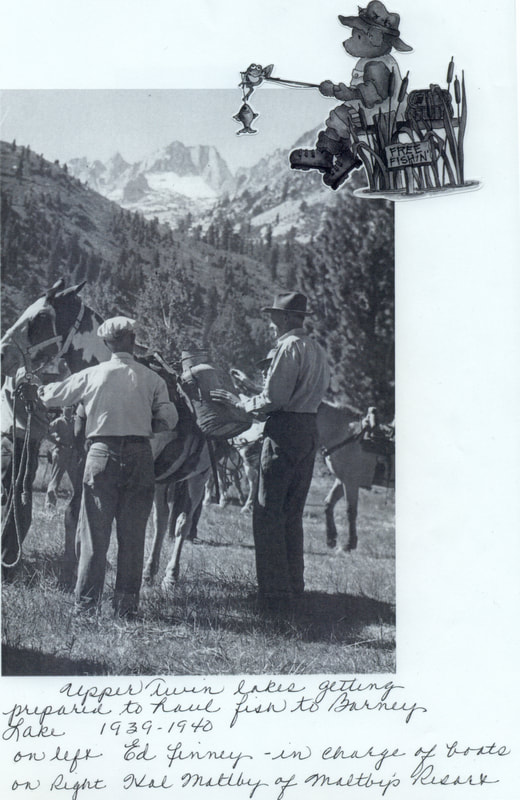|
FISH PLANTING PRIOR TO AERIAL STOCKING OF HIGH SIERRA LAKES
Written by Marye Roeser After World War II ended in 1946, California Department of Fish and Game began aerial fish planting using Army planes and pilots to plant hatchery raised fingerling trout in the lakes and streams of the Sierra Nevada Mountains. Much of the Sierra is road less wilderness and is not accessible by vehicle. Prior to aerial drops, fingerling trout were planted in these lakes with strings of mules carrying special fish cans and then on the backs of packers and crew to their destination. These early aerial drops were still not able to plant all lakes due to the restrictions of the early airplanes of that time. Fish hatcheries scattered around the Sierra collected trout eggs and raised trout until they could be planted in the area lakes and streams. Rainbow Trout were the most commonly planted and golden trout were planted in high lakes where suitable habitat was found. Special aerated tanker trucks hauled the “catch-able" fish to the appropriate lakes and streams that they could access. Since the majority of the Sierra lakes and streams are located away from roads; commercial pack stations provided mule transportation for these tiny fish. Their destination; new watery homes in the vast Sierra Nevada range. Fish and Game trucks would haul fingerlings to pack stations where they would transfer the fingerlings to fish cans. These fish cans would then travel by mule back to the high lakes and creeks. These specially designed and constructed cans hold the little fish in water while traveling until they could be poured into the destination lakes and streams. A mule can carry one can on each side hooked onto the packsaddle and lashed in place. In 1952, Lou Roeser remembers helping in the yard at Mammoth Lakes Pack Outfit with a fish planting trip to plant small trout fingerlings. These fingerlings were raised in the Hot Creek Fish Hatchery and trucked to the pack station in a fish planting truck. Stout, gentle pack mules were saddled and cinched ready for the fish cans to be loaded with tiny, young fish. As soon as the cans were packed on a mule that mule would be kept moving by the mounted packer as additional packed mules were tied into the mule string. Trout need adequate oxygen in the cold water and this constant movement kept the water in the cans aerated so the little fish could obtain their necessary oxygen. The mule packer would then move out on the trail leading to the lakes. Employees from California Fish and Game accompanied the packer and mule string to organized the pouring out of the fish at the chosen site(s). The mules were brought as close as possible to the fingerlings planned destination. When the mule strings could not be brought to the waters edge the men than backpacked the fish cans the rest of the way. That same year, Russ Johnson, the owner of McGee Creek Pack Station and Cliff Brunk with California Dept. of Fish and Game, packed golden trout up to Baldwin Lake and a creek above Horsetail Falls. They led the mules as far as feasible. They then hiked, carrying the cans on their backs the remainder of the way. Today, California Department of Fish and Wildlife conducts aerial fish planting with more modern aircraft and schedules air drops every 3 years for each lake. Lakes with more fishing pressure are planted more often. The “Packer with the Mule String” planting method was used throughout the Sierra Nevada range to stock backcountry lakes for many years and still today in some more inaccessible basins. The Sierra have become famous for the great fishing opportunities to be found in many of the lakes, river and creeks throughout the mountain range.
0 Comments
Leave a Reply. |
AuthorAmerican Mule Museum: Telling the story of How the West Was Built – One Mule at a Time Archives
January 2021
Categories |





